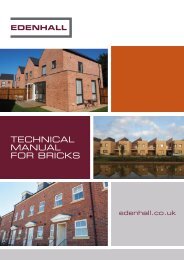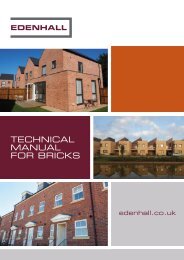Create successful ePaper yourself
Turn your PDF publications into a flip-book with our unique Google optimized e-Paper software.
BRICK TECHNICAL BULLETIN<br />
PRODUCT COMPARISON<br />
BTB 2<br />
This <strong>Technical</strong> Bulletin details the comparison between <strong>Edenhall</strong> concrete bricks and clay bricks. Historically there was also a third<br />
type of brick used in the British Isles, namely the Calcium Silicate or Sand Lime brick, but as these are no longer produced in this<br />
country they have been ignored for comparison purposes.<br />
BRITISH STANDARDS<br />
Concrete bricks are produced to BS EN 771-3: Aggregate Concrete Masonry Units. This replaced BS 6073: Parts 1 and 2.<br />
Clay bricks are produced to BS EN 771-1: Clay Masonry Units. This replaced BS 3921.<br />
Both Standards for concrete masonry and clay units specify the characteristics and performance requirements for both products<br />
but do not give any reference to their use or application. This is covered generally by BS 5628: Code of Practice for Walling, now<br />
replaced by a new Standard PD 6697:2010 and other Codes and Standards.<br />
COMPRESSIVE STRENGTH<br />
<strong>Edenhall</strong> bricks have a minimum compressive average strength of 22.5N/mm 2 , increasing where required to 50N/mm 2 . Concrete<br />
bricks continue to gain strength with age.<br />
Clay bricks vary in strength, depending on type, with a typical strength range of 15-90N/mm 2 . There is no strength gain with clay<br />
bricks.<br />
Strength and cement content are indicative of durability in <strong>Edenhall</strong> bricks, whereas in clay bricks strength is a function of the<br />
constituent raw material and firing technique. For example, in PD 6697 the minimum strength requirement for use in a typical<br />
external wall above and below dpc requires a concrete brick of 22.5N/mm 2 , whereas a clay brick has to be selected from one with<br />
the preferred frost resistance and soluble salts content.<br />
DIMENSIONS<br />
The tolerances on concrete bricks are broken down into three categories:<br />
D1: +3-5mm in all dimensions<br />
D2: +1-3mm in all dimensions; ±2mm in height<br />
D3: +1-3mm in all dimensions; ±1.5mm in height<br />
Clay brick tolerances are:<br />
T1: +1-6mm if the bricks are between 209-221mm in length<br />
T2: +1-4mm if the bricks are between 211-219mm in length<br />
T1: +1-6mm if the bricks are between 59-71mm in height<br />
T2: +1-4mm if the bricks are between 61-69mm in height<br />
Fundamentally concrete bricks, because of their manufacturing method, tend to be produced to finer tolerances than clay bricks.<br />
<strong>Edenhall</strong> bricks are produced and certified to D1 category.<br />
DURABILITY<br />
Durability in the form of frost resistance and soluble salts content in concrete bricks is a function of the compressive strength and<br />
mix design. Independent tests that have been carried out by the Building Research Establishment and other approved Testing<br />
Laboratories have confirmed that concrete bricks are frost resistant in most locations. They may not however be resistant to de-icing<br />
salts or certain situations experiencing high wear or high acid environments.<br />
Further tests show <strong>Edenhall</strong> bricks to have a minimal soluble salts content and the admixtures used both within the mix and on the<br />
surface of certain facing bricks ensure that bricks have minimal efflorescence.<br />
By contrast clay bricks may contain metallic salts such as sodium, potassium and magnesium, and consequently are categorised as<br />
either SO, S1 or S2. These define the maximum level of soluble salts.







